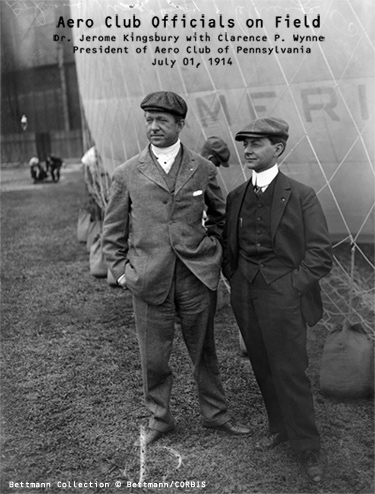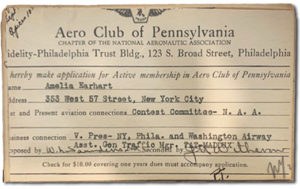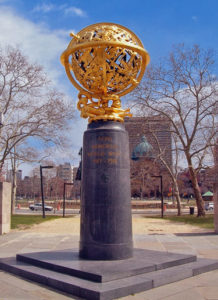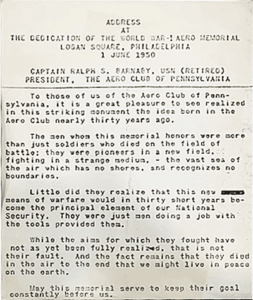A brief history of the Aero Club of Pennsylvania
Organized in December 1909 and chartered on May 13, 1910, the Aero Club of Pennsylvania is one of the nation’s oldest continuously operating aviation clubs in America. See list of other Notable Aero Clubs.
Our By-Laws
Revised 2014: By-Laws (PDF)
A Brief History
-
- In May, 1910 Henry S. Gratz, First Vice-President, presented the club with his 35,000 cubic foot ballo0n “Initial”, capable of carrying 3 persons.
- At the December 17, 1934 First Flight Dinner, the Aero Club sent a telegram to the Wright Brothers, honoring the 31st anniversary of their historic flight.
- The Aero Club sponsored the Aero Memorial, dedicated and erected in June 1950, opposite the entrance to the Franklin Institute on Logan Circle. It honors the lost fliers of World Wars I and II.
- In 1938, the Aero Club began rewarding scholarships under the auspices of the Hollinshead N. Taylor Memorial Scholarship Fund. The tradition of awarding scholarships to deserving young aviation students endures to the present day.
- In 1993, Paul Heintz, Esq. obtained 501(c)(3) status for the Aero Club of Pennsylvania Memorial Scholarship Fund.
- See list of Past Aero Club Presidents.
- List of recent Wright Brothers Award winners.
- List of recent Wright Brothers Dinner Speakers.
- List of recent Past Field Trips.

The History, Then and Now
On December 17, 1909, the first licensed balloonist in Pennsylvania, Arthur T. Atherholt assembled fourteen citizens of the city of Philadelphia to propose the formation of a new aviation organization. Its purpose was to supervise and encourage the growing interest in aviation in the Commonwealth of Pennsylvania. On January 10, 1910, rules were adopted, officers elected, and Jurisdiction assumed in Pennsylvania through the Aero Club of America. Incorporation was established on May 13, 1910 through the granting of a State Charter. In the same year, four leading balloon groups, the Aero Club of Philadelphia, the Ben Franklin Aeronautical Society, the Aeronautical Recreational Society, and the Ben Franklin Balloon Association, merged with the new organization.
At this time the Aero Club became one of the first chapters of the National Aeronautic Association (NAA) with its “first NAA Flying Unit” [NAA Certificate of Charter].
The Aero Club’s initial club grounds were at Clementon, NJ. There, members developed an airfield in 1910 that had been utilized by the Philadelphia Motordrome Association.
 A logo was adopted which depicted a witch on a broomstick bordered by the Pennsylvania Keystone. This likely came directly from a letter written by Ben Franklin in 1783 to an English friend after witnessing the first human balloon flights, which said, “A few months since, the idea of witches riding thro’ the air upon a broomstick, would have appeared equally impossible and ridiculous.”
A logo was adopted which depicted a witch on a broomstick bordered by the Pennsylvania Keystone. This likely came directly from a letter written by Ben Franklin in 1783 to an English friend after witnessing the first human balloon flights, which said, “A few months since, the idea of witches riding thro’ the air upon a broomstick, would have appeared equally impossible and ridiculous.”

The first decade was marked by much activity, predominantly with balloons. In these early years, four members owned aeroplanes, and others were building their own.
Through the efforts of Henry M. Neety of the Aero Club, the largest aviation show ever held in America opened at the Armory in Philadelphia on November 3-10, 1910. Thirty thousand spectators attended the accompanying Air Show that was held at the Philadelphia Driving Park at Point Breeze RaceTrack.
Click to see image of the 1910 Air Meet Poster.
The Aero Club also had a balloon entry in the Gordon Bennet Race of 1910, called the Pennsylvania II.
In 1912, the Aero Club established Eagle Field in the town of Manoa, three miles west of Philadelphia. A concrete block hangar was built from which Grover C. Bergdoll made the first airplane flight from Philadelphia to Atlantic City. By 1915, ten members were pilots.

Many noted persons were members in this period including Rodman Wanamaker, Grover and Lewis Bergdoll and Hugh Willoughby who had built several airplanes of his own design. The club was a leader in calling for the enactment of laws and regulations to curb recklessness and incompetence. As early as 1913, the Aero Club submitted a bill to Congress captioned “For the Federal Control of Aviation” and contributed to several other pieces of legislation throughout this period.

Also in this decade, Robert Glendinning and other Aero Club enthusiasts were instrumental in the establishment of a facility to train pilots in the techniques of water operation. This was known as the Philadelphia School of Aviation and was located on the banks of the Delaware River south of the Philadelphia Navy Yard. This Essington Seaplane facility, managed by Frank Mills, was one of four sites when the United entered the World War in 1917. Also during this time, an early Aero Club president, Joseph A. Steinmetz, established the School of Aircraft Building in Philadelphia.
The 20’s and 30’s
The twenties ushered in increasing activity in aircraft and the club included among its members several aviation businessmen such as W. Wallace Kellett, C. Townsend Ludington and Harold F. Pitcairn. At that time the Aero Club was headquartered at Pitcairn Field at Willow Grove. It was at this field that the Pitcairn-Cierva autogiro was assembled and test flown. A contributing aerodynamic designer was Ralph H. McLarren, a former Aero Club president.
Members supported the idea of more airport facilities, and later established a clubhouse on the small Municipal Airport in Philadelphia. Aero Club members also developed and managed the Central Airport in Camden, NJ that was dedicated on September 21, 1929. Camden Central Airport would become “Philadelphia’s Airport” for over 15 years.

In 1928, President W. Lawrence Saunders sponsored Amelia Earhart as a member of the Aero Club.
The number of pilots continued to grow. Airlines began operation, autogiros were introduced, and the need for an adequate municipal airport was recognized. At this time, in April 1931, Amelia Earhart set an altitude record of 18,415 feet in a Pitcairn-Cierva autogiro at Willow Grove’s Pitcairn Field. The club opened a combined airline ticket office and club room on the street level of the Fidelity Building at Broad and Walnut Streets, which was the first such operation in the city of Philadelphia.
Membership numbered several hundred, with public meetings held to encourage support for better airport facilities.

Both the Aero Club and the Aviation Committee of the Philadelphia Chamber of Commerce approached the City of Philadelphia to point out that rapid non-aviation growth would very quickly use up all available space in Philadelphia, leaving none for an expanded airport facility. Philadelphia Municipal Airport, dedicated by Charles A. Lindbergh in October 1937, was regarded as “too small.” The Lecture Hall of the Franklin Institute was used for many of the public gatherings that followed. These meetings finally led to a grand affair at the Penn Athletic Club in December 1939. This was the true beginning of tangible progress towards the start of a modem city airport.
Through the joint efforts of the Aero Club of Pennsylvania, J. Victor Dallin, another early president, and Alfred L. Wolf, C. Townsend Ludington, the Philadelphia Chamber of Commerce, and others, the Philadelphia International Airport came into being and was dedicated by Mayor Robert E. Lamberton in 1940. The annual tradition of the Aero Club of Pennsylvania honoring the Wright Brothers on the anniversary of their First Flight began with a dinner on December 17, 1934. A telegram complimenting their accomplishments was sent to Orville Wright by the Aero Club on the 31st anniversary of this historic event. Also during this period, in 1938, the Hollinshead N. Taylor Memorial Scholarship Fund was formed. This scholarship was founded by a bequest from the Hollinshead Taylor estate in memory of Mr. Taylor who was president of the club in 1928. It was established to award scholarships to deserving candidates between the ages of 18-22 who lived within a radius of forty miles of Philadelphia’s City Hall to further their careers In aviation. The scholarship program still exists and is now known as the Aero Club of Pennsylvania Memorial Scholarship Fund.
The 40’s, 50’s, 60’s, 70’s
World War II called Aero Club members to serve their country in many different capacities. Flying activities were curtailed and didn’t resume until 1949.


In June 1950, The Aero Memorial, sculpted by Paul Manship, was dedicated and erected opposite the entrance to the Franklin Institute on Logan Circle. The Aero Club was responsible for this memorial that was initially proposed in 1918 and Jointly funded by the Fairmount Park Art Association at a final cost of $35,000. It honored the lost fliers of World Wars I and II.
After World War II, Philadelphia became the center for rotary wing development through the Piasecki Aircraft Company. Private flying and airline travel began to grow in earnest. Aviation had reached a stage of acceptance and maturity with the general public. The Aero Club’s early advocacy role led to this acceptance. During this period, the club began to award scholarships on a regular basis. Between 1962 and 1979, thirty-seven scholarships were awarded. In 1971, the Bob Shannon Memorial Fund was created to award scholarships to candidates between the ages of 16-19 who lived in the Delaware Valley.
Also at this time, local chapters of the Aero Club started in counties surrounding Philadelphia, including the Aero Club of Chester County, Inc. and the Delaware County Aviation Association. Support for regional airports was undertaken, and several major activities were sponsored, such as Sportsmen Pilot Races, Powder Puff Derbies, and Air Shows.
The 80’s and 90’s
A concerted effort was undertaken to renew the earlier strength of the Aero Club. The club undertook a new membership campaign and created stronger bonds with other aviation groups, including the Pennsylvania Aviation Council in Harrisburg. A regular newsletter and member discount program was initiated. A newer modern logo was approved and adopted and the by-laws were reformulated and approved reflecting present day Aero Club operations. The scholarship program was restructured and reinstated in 1987 by Paul Heintz, Esquire, as the Aero Club of Pennsylvania Memorial Scholarship Fund.
Additionally, the club sponsored a visit of a B-17 to the Willow Grove Naval Air Station and participated in the 200th anniversary celebration of the First Air Voyage In America (FAVIA). The club also established an annual Aviation Career Night and Aviation Awareness Day and sponsored numerous FAA Aviation Safety Programs focusing on pilot proficiency.
In 1993, the Aero Club of Pennsylvania Memorial Scholarship Fund received tax exempt status from the IRS. This was done to position the Fund to actively solicit financial contributions for larger future scholarships. With the restructuring of the fund and the tax-exempt status the Aero Club has awarded to date an additional 31 scholarships since 1987.
A New Century
The 21st Century has brought renewed activity in the Aero Club. Long-time president Al Schnur stepped down to open the club to new leadership. A new two-year term for president was enacted to help attract new leadership without the burden of
a lengthy committment. This also helps ensure that new ideas will be injected into the operation of the club. A new first vice-president position was created to ensure a smooth transition to president.
What was begun under the leadership of Al Schnur and Paul Heintz, esq, the Scholarship Fund has grown with new donations and annual investment growth, allowing the club to offer larger scholarships each year. The awards were broadened to include scholarships for more types of aviation training.
The club newsletter was revamped in 2000 by Rob Dant and offers pertinant Delaware Valley aviation news not available elsewhere.

Club membership has remained steady at around 200 members. Renewed membership drives have helped attract new members with new ideas.
Beside the annual Wright Brother’s Dinner and Scholarship Dinner, the club has become more active in local aviation.
The club co-sponsors Safety Seminars with the FAA, and holds an Fly Market in September to raise funds for the Scholarship Fund. Numerous aviation related field trips have been organized for the benefit of the membership. Trips included visits to the Cradle of Aviation Museum, the Udvar-Hazy Museum, the old Floyd Bennett Field in Brooklyn, the Intrepid Museum, and to visit some private local aircraft collections.
The Aero Club Memorial Scholarship Program continues to grow in size and impact. Since the year 2000, the program has awarded over $450,000 in scholarships to young men and women seeking careers in aviation.
Last updated: Feb 2021 – RLD
